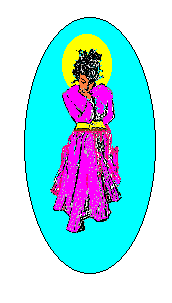Scriptures
The Church of Gnostic Luminism will recognize the
traditional religious writings of all cultures as Holy Writ, with the proviso
that certain dilutions and corruptions of the original Divine Inspiration may
have occurred, in the writing itself, or in the transmission of it over
generations and centuries. Therefore the rule of syncretic and eclectic
evaluation in the light of each aspirant’s own Gnostic Illumination applies to
these writings, as to all.
In addition, certain other writings, ancient or
modern, that are not included in any established canon, but that bear witness to
True Inspiration, will be recognized by the Church as authoritative scriptures.
The following are among the primary Scriptures
recognized by the Church of Gnostic Luminism:
 the Tao Te
Ching
the Tao Te
Ching
 the
I Ching
the
I Ching
 the Bhagavad Gita
the Bhagavad Gita
 the Mahabarata
the Mahabarata
 the Vedas
the Vedas
 the Upanishads
the Upanishads
 the Yoga Sutras of
Patanjali
the Yoga Sutras of
Patanjali
 the Ramayana
the Ramayana
 the Srimad Bhagavatan
the Srimad Bhagavatan
 the
Kama Sutra
the
Kama Sutra ,
the Ananda Ranga ,
the Ananda Ranga ,
and the Yoni
Tantra ,
and the Yoni
Tantra
 the Dhammapada
the Dhammapada
 the Diamond Sutra
the Diamond Sutra and
the Heart Sutra
and
the Heart Sutra
 the
Bardo Thodol
(Tibetan Book of the Dead)
the
Bardo Thodol
(Tibetan Book of the Dead)
 the Papyrus of Ani (Egyptian Book
of the Dead)
the Papyrus of Ani (Egyptian Book
of the Dead)
 the Stele of
Revealing
the Stele of
Revealing
 the Golden Verses of
Pythagoras
the Golden Verses of
Pythagoras
 the Zend-Avesta
the Zend-Avesta
 the Corpus
Hermeticum
the Corpus
Hermeticum
 the Nag Hammadi Library
the Nag Hammadi Library and other extant Gnostic texts
and other extant Gnostic texts
 the Holy Bible,
including the Apocrypha
the Holy Bible,
including the Apocrypha
 the Qur’an
the Qur’an
 the Marriage of
Heaven and Hell
the Marriage of
Heaven and Hell and the other Prophetic and Illuminated Books of
William Blake and the other Prophetic and Illuminated Books of
William Blake
 Morals and Dogma
Morals and Dogma of the Ancient and Accepted
Scottish Rite Freemasons
by Albert Pike of the Ancient and Accepted
Scottish Rite Freemasons
by Albert Pike
 Oahspe
Oahspe ,
Urantia ,
Urantia ,
Thinking And Destiny ,
Thinking And Destiny
 The Aquarian Gospel
The Aquarian Gospel
 Septem Sermones ad Mortuous
(Seven Sermons to the Dead), a channeled
document received by Carl Jung
Septem Sermones ad Mortuous
(Seven Sermons to the Dead), a channeled
document received by Carl Jung
 Life Eternal
And Its Work
Life Eternal
And Its Work
 Liber AL
vel Legis
Liber AL
vel Legis
 The Holy Books of Thelema
The Holy Books of Thelema
Saints and Prophets
Certain persons, both historical and contemporary,
will be recognized by the Church of Gnostic Luminism as Saints and Prophets.
Such recognition implies that these persons have shown evidence of Divine
Inspiration to such a degree that they have contributed measurably to the
spiritual evolution and liberation of the human race. This recognition does not
necessarily imply “perfection” or infallibility, however; and as in all things,
their teachings must be evaluated by the syncretic/eclectic method in the light
of each student’s own Gnostic Illumination.
The Church of Gnostic Luminism will honor the
Collect of the Saints from Crowley’s
Gnostic Mass . .
Additionally, the following will be among the
figures particularly selected for recognition:
 Legendary figures, which may have a historical basis although exoteric knowledge
of their Earthly lives has been lost, or is uncertain:
Legendary figures, which may have a historical basis although exoteric knowledge
of their Earthly lives has been lost, or is uncertain:
 Lao Tzu
Lao Tzu
 Krishna
Krishna ,
Rama ,
Rama ,
Shiva ,
Shiva
 Siddhartha Gautama
Siddhartha Gautama ,
Padma Sambhava ,
Padma Sambhava
 Zoroaster a/k/a Zarathustra
Zoroaster a/k/a Zarathustra
 Enoch
Enoch ,
Melchizedek ,
Melchizedek ,
Solomon ,
Solomon ,
Christ ,
Christ
 Thoth
Thoth a/k/a
Tahuti
a/k/a
Tahuti ,
Hermes
Trismegistus ,
Hermes
Trismegistus
 Quetzalcoatl
Quetzalcoatl
 Merlin
Merlin ,
Arthur ,
Arthur
 Historical figures:
Historical figures:
Pythagoras

Jaques de Molay

Adam Weishaupt

St. Francis

Joan of Arc

Giordano Bruno

Baruch Spinoza

William Blake

John Humphrey Noyes

Helena P. Blavatski

Aleister Crowley

Mohandas Gandhi

Black Elk

Wilhelm Reich

Aldous Huxley

Timothy
Leary

Terence McKenna

Albert
Hofmann

 Contemporary figures:
Contemporary figures:
Stephen Gaskin

|


 BACK
BACK